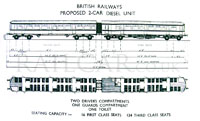Derby Lightweight (Red Triangle) 2-car DMUs
Origins
British Railways was a late starter in introducing diesel multiple units. They observed other countries experiences for several years before the Railway Executive announced a £500,000 trial programme in November 1952 to introduce eight lightweight units to the West Riding of Yorkshire. These new and frequent diesel services were expected to greatly improve the services and develop travel between large population centres such as Leeds and Bradford, with it's series of interconnected lines and busy industrial areas. The announcement stated that it was estimated that they would create operating savings of £8,000 annually by taking over 309,000 miles of steam mileage, and increase takings by £22,000.

The drawing on the right shows an early proposal, still recognisable as the units that would be built, but with many interesting differences. Most noticeable is the half-width driving cab with passenger seats to its side, a concept that would appear later on the 4-wheel railbuses. The railbuses would not have first class area, which there are in both vehicles on the diagram (the front saloons). There were three vestibules shown in each car rather than the two they would received, sideways seats near these no doubt was to allow extra standing space. The power car contains the toilet (they were built with the toilet in the trailer cars); other early design drawings have the round object in the van identified as a steam heating boiler. These other early drawings show that the drive to the wheels were planned to be in the style of the GWR railcars, with the cardan shaft connected to the outside of the axles. This drawing also shows trussing in the underframe; this had been the design concept for coaching stock for many years providing rigidity to the vehicles. This was eliminated by the time the vehicles were built, providing much needed extra underframe space for the variety of equipment that had to be fitted beneath the solebar. This was achieved by having a stronger bodyshell through the use of special alloy extrusions which spread the strength to different areas of the body.
They were designed by a team headed by R.A. Riddles, who at the time was the Member of the Railway Executive responsible for Mechanical & Electrical Engineering. The power twins were to have Leyland 125hp engines with hydraulic transmission, 16 first class and 114 second class seats. They were put into production at BR’s Derby C&W works, at a cost of £16,000 per car. As can be expected, the design of the vehicles developed from the first ideas to what was built.
The units were intended to undergo a testing period before being built en-mass as the standard for use throughout the country. However in September 1953, long before the first vehicles were completed, it was announced that the scheme would be extended to include the West Cumberland area. This was soon followed by anouncements for schemes to be introduced as soon as possible in Lincolnshire, in East Anglia, between Newcastle and Middlesborough, and between Edinburgh and Glasgow. Allocated expenditure on these new diesel trains now stood at £2 million. This was still before delivery of the first set!


